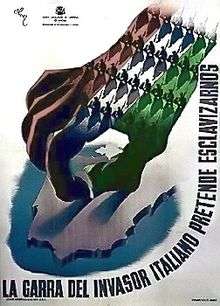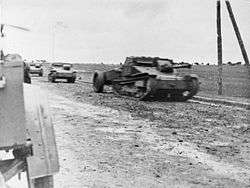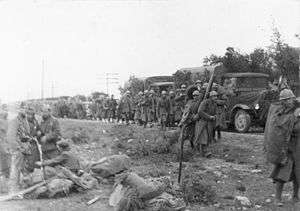Corpo Truppe Volontarie
| Corps of Volunteer Troops Corpo Truppe Volontarie | |
|---|---|
|
A column of Italian troops at the Battle of Guadalajara. | |
| Active | December 1936 - April 1939 |
| Country |
|
| Allegiance |
|
| Branch | Army |
| Type | Infantry |
| Role | Motorized infantry |
| Size |
• 50,000 troops • 758 planes |
| Engagements | |
| Commanders | |
| Notable commanders | |
The Corps of Volunteer Troops (Italian: Corpo Truppe Volontarie, CTV) was a Fascist Italian expeditionary force which was sent to Spain to support the Nationalist forces under General Francisco Franco against the Spanish Republic during the Spanish Civil War, 1936-39.[1]
Background
In July 1936, at the beginning of Spanish Civil War, most of the elite Nationalist forces were isolated in Spanish Morocco or on the Canary Islands. Meanwhile, in Spain, smaller formations of Nationalists and Guardia Civil forces were locked in combat with pro-government militias, Assault Guards and those army units which remained loyal to the leftist Popular Front government. Making the situation more difficult for the Nationalists was the fact that the Spanish Republican Air Force and Navy generally remained loyal to the government.
If the Nationalist forces fighting in Spain did not receive reinforcements, the rebellion could soon fail. General Franco and the other Nationalist leaders sent emissaries to Berlin and Rome to ask for help. Both German dictator Adolf Hitler and Italian dictator Benito Mussolini immediately responded in a positive manner. They sent transport aircraft and crews to Morocco to airlift Nationalist forces from there to Spain. The colonial troops from Morocco allowed the Nationalist forces to take the initiative on mainland Spain.
The Italians also used Nationalist-held, and also Portuguese, harbours as staging points for sending supplies to the Nationalist forces, and also for landing Spanish troops to support the rebellion. Italian submarines began to sink Spanish, Soviet and other nations' ships transporting materials through the Mediterranean to Republican harbours. However action by the League of Nations resulted in the Nyon Agreement of September 1937, which classed these operations as acts of piracy, and was enforced by the French Navy and the British Royal Navy.[2]
Commanders
The following are the commanders of the Corps of Volunteer Troops and significant battles fought with CTV participation while they were in command:
- General Mario Roatta - Commander-in-Chief of the CTV, from 1936 to 1937
- Battle of Málaga - Nationalist victory
- Battle of Guadalajara - Republican victory
- General Ettore Bastico - Commander-in-Chief of the CTV, 1937
- Battle of Santander - Nationalist victory
- General Mario Berti - Commander-in-Chief of the CTV, from 1937 to 1938
- Aragon Offensive - Nationalist victory
- General Gastone Gambara - Commander-in-Chief of the CTV, from 1938 to 1939
- Catalonia Offensive - Nationalist victory
Timeline
1936

3 September : Republican forces from Catalonia, under the command of Captain Alberto Bayo, made a landing on Majorca. His formations were the target of Italian air forces which attacked on 24 October. On the same date, Italian bombers and fighters launched their first air raid on Madrid. This was intended to demonstrate to the Republican forces the power of Franco's allies. In the following days, they began a series of bombing raids on the Spanish capital.
2 November : Italian and German bombers and their fighter escorts were attacked by Soviet aircraft, nicknamed "Chatos" by the Spanish, which resulted in some losses for the Italians.
12 December : After the failure of Franco's offensive on Madrid, Mussolini decided to send regular army forces to Spain. Mussolini made this decision after consulting with Italian Minister of Foreign Affairs Galeazzo Ciano and General Mario Roatta. Ciano and Roatta were two of the most influential men in Italy at the time. Roatta was made the Commander-in-Chief of the Italian "expeditionary force." General Luigi Frusci became his Deputy Commander.
23 December : The first formation of 3,000 troops landed in Cadiz. They were called the "Italian Army Mission."
1937
January: By this time, approximately 44,000 regular Italian army soldiers and members of the Fascist paramilitary (Blackshirts) were in Spain. At the end of February, the "expeditionary force" was renamed the "Corps of Volunteer Troops" (Corpo Truppe Volontarie, or CTV). The CTV was organised into four divisions:
- 4th "Littorio" Infantry Division (Lictor) - A fully motorized infantry division of the Italian Royal Army (Regio Esercito).
- 1st "Dio lo Vuole" Blackshirt Infantry Division ("God wants it")
- 2nd "Fiamme Nere" Blackshirt Infantry Division ("Black Flames")
- 3rd "Penne Nere" Blackshirt Infantry Division ("Black Feathers")
The Blackshirt (Camicie Nere, or CCNN) Divisions contained regular soldiers and volunteer militia from the Fascist Party. The CCNN divisions were semi-motorised. There it also had the independent XXIII de Marzo Group of CCNN infantry.
The Italian CTV also had a Tank and Armoured Cars Group, Corps Artillery of ten regiments (Groups) of field artillery, and four batteries of anti-aircraft artillery.
3 February to 8 February: The 1st CCNN Division "Dio lo Vuole," in support of the Nationalists, launched an offensive against Málaga. On 8 February, the Italians and Nationalists captured the city. The Battle of Málaga was a decisive victory for the Nationalists. About 74 Italian soldiers were killed, 221 wounded, and two missing in the battle.
March: The Corps of Volunteer Troops now numbered over 50,000 troops.

8 March to 23 March: Benito Mussolini decided that Fascist Italian forces should lead a fourth offensive on Madrid. This Italian offensive resulted in the Battle of Guadalajara, which ended as a decisive victory for the Republican forces. In contrast, the Italian forces suffered heavy losses. The Italian armor, consisting for the most part of L3/35 tankettes, proved to be no match for the tanks provided to the Republicans by the Soviet Union. The Italian offensive was repulsed by a strong Republican counter-offensive led by the 11th Division. Of the four Italian divisions engaged, only the Littorio Division did not suffer heavy losses. The three CCNN divisions had such heavy losses that they had to be reorganized into two divisions and a special weapons (armour and artillery) group. The 3rd CCNN Division was disbanded and consolidated with the 2nd CCNN Division in April 1937.
From this point until the end of the war, the commanders of the Italian Corps did not organize their own offensives. Instead they acted under the Nationalist command. Similarly the commander of the Nazi German Legion Condor, General Hugo Sperrle, commanded the Italian air force in Spain.
April to August: As the CCNN Divisions were reduced, Italians began to serve in mixed Italo-Spanish Flechas ("Arrows") units where the Italians provided the officers and technical personnel, while the Spanish served in the rank-and-file. The first were the Flechas Azules (“Blue Arrows”) Mixed Brigade and the Flechas Negras (“Black Arrows”) Mixed Brigade, that served respectively in Extremadura and Viscaya from April to August 1937. Also in Viscaya were the CTV's XXIII de Marzo Group and 11 Artillery Groups.
August to September: Roatta's replacement, General Ettore Bastico, commanded the CTV forces including the Division XXIII di Marzo, formed from the XXIII de Marzo Group. The CTV broke the Republicans' lines near Soncillo, captured a key pass, the Puerto del Escudo, and penetrated deep into the Republican rear during the Battle of Santander, resulting in a decisive victory for the Nationalists. After that they were transferred to the Aragón Front. Some CTV forces may have been involved in the Battle of El Mazuco, but details are unconfirmed.
October: After the northern campaigns, the 1st CCNN Division and 2nd CCNN Division were consolidated with the Division XXIII di Marzo and renamed the XXIII de Marzo - Llamas Negras Division.
1938
March : The Flechas Negras Brigade was expanded into the Flechas Division "Arrows" serving in the Aragon Offensive and the March to the Sea with the CTV now under Mario Berti.
18 March: Barcelona was the target of thirteen Italian large-scale air raids. The Italian aircraft were armed with incendiary and gas bombs, which resulted in the death of around 2,500 civilians.
November : The Flechas Division was strengthened renamed "Flechas Negras" and the Flechas Azules Brigade was expanded into two other Flechas Divisions that took part in the Catalonia Offensive the final offensive of the war, along with the rest of the CTV under Gastone Gambara:
- Flechas Negras Division "Black Arrows"
- Flechas Azules Division "Blue Arrows"
- Flechas Verdes Division "Green Arrows"
1939
February: Following the victory of Franco and the Nationalists over the Republicans, General Bastico and the Italian volunteers withdrew from Spain.
Aftermath
On 1 April 1939, the success of the Nationalists meant that the Italians now had a friendly regime in the western Mediterranean. But they acquired this friend at a high cost in both men and materials. Of the approximate 78,500 men sent to Spain, 2,989-3,819 were killed and about 12,000 (10,629) were wounded. Those casualties were mostly caused during the Catalan and Aragonese Offensives, about 44% of the deaths and 43% of the wounded, and the rest during the Guadalajara, Santander and Levante offensives.[3] The Italian military left behind roughly 3,400 machine guns, 1,400 mortars, 1,800 artillery pieces, 6,800 vehicles, 160 tanks, and 760 aircraft. But, while the military equipment represented a loss to Italy's war inventory, most of the equipment was obsolete. The financial cost of the war was more debilitating. The cost of the CTV to Italy amounted to between 6 and 8.5 billion lire. At 14 to 20 percent of annual expenditure, this represented an immense drain on the Italian economy. The high cost of Mussolini's Spanish adventure severely handicapped Italy in the period leading up to World War II.[4]
See also
- Italian Royal Air Force (Regia Aeronautica) and Aviation Legion (Aviazione Legionaria)
- Italian Royal Navy (Regia Marina) and Submariners Legion (Sottomarini Legionari)
- Luigi Frusci - Deputy Commander-in-Chief of the CTV
- Giorgio Perlasca - served in the CTV with honors. He later used his letter of commendation from Franco to pass for a Spanish diplomat in Budapest, saving thousands of Hungarian Jews from the Nazi extermination camps.
- Santoña Agreement - the surrendering of the Basque Army to the CTV.
Footnotes
Further reading
- Podmore, Will. Britain, Italy, Germany and the Spanish Civil War (1998)
- Rovighi, Alberto, and Filippo Stefani. La Partecipazione Italiana Alla Guerra Civile Spagnola (1936-39) (2 vol 1993)
- Sullivan, Brian R. "Fascist Italy's military involvement in the Spanish Civil War," Journal of Military History (1995) 59#4 pp 697–727.
- Walker, Ian W. (2003). Iron Hulls, Iron Hearts : Mussolini's elite armoured divisions in North Africa. Marlborough: Crowood. ISBN 1-86126-646-4.
Sources
- Hurtado, Víctor; Segura, Antoni; Villarroya, Joan (2012). Atles de la Guerra Civil a Catalunya (book) (in Catalan) (2nd ed.). Barcelona: Edicions DAU and Ajuntament de Barcelona. ISBN 978-84-9850-382-1.
- de Mesa, José Luis, El regreso de las legiones: (la ayuda militar italiana a la España nacional, 1936-1939), García Hispán, Granada:España, 1994 ISBN 84-87690-33-5
- Leon Wyszczelski "Madryt 1936-1937" Historical Battles published by Ministry of National Defence, Warsaw 1988.
- Some details from the Republican perspective on the Italian military in Spain appears in the works of Luigi Longo, a former organizer of the International Brigades.
- Information on Italian army activities appearing in this article was taken from lacucaracha.info "La Cucaracha": Civil War in Spain 1936-1939 Official website.
